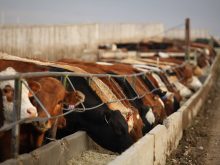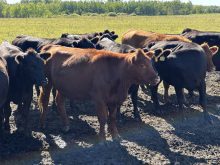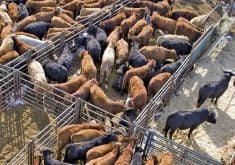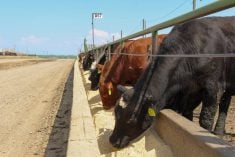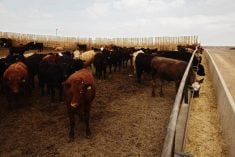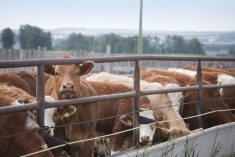During the first half of April, Alberta packers were buying fed cattle on a live basis at $240 per hundredweight delivered, up $8/cwt from a month earlier.
Market-ready fed cattle supplies in Alberta and Saskatchewan are tightening, causing the fed cattle basis to strengthen.
While the Canadian domestic slaughter is running slightly below year-over-year levels, fed cattle exports to the U.S. are sharply higher.
In Kansas and Texas, fed cattle were trading at US$185/cwt, down US$2/cwt from mid-March. In the U.S., market-ready fed cattle supplies are similar to last year while the slaughter is coming in below year-ago levels.
Read Also

Gentle treatments for pain in the neck
Heading toward year-end, people unknowingly tense up against the cold and busyness, causing neck pain that can often be treated with appropriate support and gentle mobility, athletic therapist Kathlyn Hossack says.
Fed cattle prices are expected to trade sideways in the second quarter, then strengthen in the July-through-September period. Feeder cattle prices are trading near 52-week highs with 800-pound-and-higher quality steers touching the $350/cwt level in central Alberta. Steer calves at 500 lbs. are readily trading at $470/cwt or higher in the same region. The feeder market is functioning to ration demand through higher prices, which will keep feeding margins near break-even over the next eight months.
Prices for bred cows and bred heifers continue to percolate higher as cow-calf producers on both sides of the border start to move into herd expansion.
Cattle on feed in Alberta and Saskatchewan as of March 1 were 1.015 million head, down two per cent or 19,600 head from March 1, 2023. Feedlot placements during February 2024 in the two provinces were 140,700 head, up nine per cent or 12,100 head from 12 months earlier. Feedlot marketings during February were 154,237 head, up 12 per cent or 15,965 head from February 2023.
Feedlots in Alberta and Saskatchewan are backed up with market-ready fed cattle. We estimate the backlog of market-ready cattle is about 50,000 head or nearly one week of the slaughter supply. Steer carcass weights in Alberta are up nearly 60 lbs. from year-ago levels while heifers are up 14 lbs. from the same timeframe in 2023.
While the domestic slaughter is running similar to last year, fed cattle exports to the U.S. are above year-ago levels by 2,000 to 3,000 head.
The stronger export pace is slowly cleaning up the backlog. Moving into June, there will be a deficit of market-ready fed cattle numbers. We’re expecting the basis levels during July and August to be very strong. The domestic packers will have to raise prices high enough to curb exports.
The U.S. fed cattle market is one month behind the Canadian market. U.S. feedlot inventories as of March 1 were up one per cent from year-ago levels. February placements in the U.S. were up a whopping 10 per cent from February 2023 while fed cattle marketings were up three per cent from 12 months earlier.
Cattle on feed 150 days or more as of April 1 were estimated to be up seven to eight per cent from April 1, 2023. U.S. carcass weights were up 20 lbs. over year-ago levels during the first week of April.
Packers have curtailed the slaughter to raise wholesale prices and overall margins. The U.S. fed cattle supply is expected to move into a deficit situation during July, about one month later than was earlier projected.
During the last week of March, U.S. wholesale choice beef was trading at US$305/cwt, up US$10/cwt from a month earlier and up US$20/cwt from the average for March 2023. While wholesale beef prices are up seven per cent from year-ago levels, U.S. retail beef prices are up eight per cent to 10 per cent from last year.
U.S. restaurant spending is running six to seven per cent above year-ago levels. U.S. first-quarter gross domestic product has potential to finish near 3.2 per cent (quarter-over-quarter annual rate). We’re expecting economic growth to continue through the second and third quarters before tapering off in the final quarter of 2024. Steady beef demand will underpin the beef and cattle complex.
Finishing feedlots experienced negative margins throughout the winter. However, the outlook for the summer and fall period appears to be more optimistic. We’re expecting a year-over-year increase in Canadian barley production while fed cattle basis levels are expected to be historically strong in July and August.
We’re expecting yearling prices during August to reach fresh historical highs, as will calf values in September. The feeder market is expected to taper off in the fourth quarter as the fed cattle market comes under pressure. Cow-calf producers and backgrounders need to have their price insurance in place with prices at historical highs.
The 2024 calf crop will likely be similar to 2023’s. However, we expect a minor year-over-year increase in the 2025 calf crop. Prices start to fade as buyers anticipate larger supplies. Keep this in mind that the market factors in the larger supplies about six to eight months before these calves come on the market.
Conclusions
Fed and feeder cattle prices are expected to percolate higher between June and September before trending lower in the final quarter of 2024. Beef demand is expected to soften in the final quarter of 2024 and first quarter of 2025. This will result in lower wholesale values and softer fed cattle prices. Feeding margins are expected to be sharply under water from October 2023 through April 2024. Cattle producers need a sharp risk management program. There will be significant downside risk after the cattle market makes historical highs in the summer of 2024.




